
 |
|
|
#1 |
|
Member
Join Date: Mar 2005
Posts: 9
|
Hello guys! Can anyone identify this sword or knife that I recently picked up at auction? Overall is approx. 22" long. Would appreciate any info. Thank you
|
|
|

|
|
|
#2 |
|
Member
Join Date: Dec 2004
Posts: 1,247
|
It's a seme from the Masai (or a nearby tribe) of East Africa. It's probably relatively old--it looks like it has a midrib and a diamond cross-section which (I believe) is an older feature. The newer ones are basically flat, built like machetes. I don't recall the date when the switch-over happened, but by old, I mean that it's likely mid 20th Century, at a guess.
Neat blade--and I'm sure the next poster on this list will have a better guess on its age. Fearn |
|
|

|
|
|
#3 |
|
Member
Join Date: Dec 2004
Location: Houston, TX, USA
Posts: 1,254
|
Ditto. This type of sword, shaped like a certain type of spear blade usually called a lion spear in N America, but AFAIK actually associated with a certain rank in the militia, is used by the pastorial massai for trimming vegitation, as well as for violence/defence and butchery. The Massai are said to not work iron, but to buy it all from farming neighbor tribes and itinerate smiths. The Watutsi swords I've seen certainly seem pretty much identical, and I even see this sword falling into the same broad category/tradition as ilwoon, etc. (mine, at least, is notably flatter and thinner, though maintaining its midrib, in the last particularly broad 1/4 at the tip). The traditional red dye is (AFAIK) a Massai thing, and it sure does show the wear; I've seen ones with no dye; perhaps it was no dye left; the 1/2 denuded rawhide is interesting to see, anyway. Does the metal binder at the sheath tip happen to be a bent up coin with a hole punched thru its center?
|
|
|

|
|
|
#4 |
|
Member
Join Date: Mar 2005
Posts: 9
|
Hello, yes it does have metal binder at the sheath tip which appears to be a bent up coin with a hole punched thru its center. Really appreciate the info.
|
|
|

|
|
|
#5 |
|
Member
Join Date: Dec 2004
Location: What is still UK
Posts: 5,925
|
Hello drzzzzz, your seme was probbaly made no earlier than the 1950s.These are carried by many tribes,Samburu ,Kikuyu ,Nandi,Masai and others across much of central east Africa.Most modern seme are ground from machete but you still find forged ones.The modern seme is also a shorter more general purpose weapon/tool than the old version which has a longer reach.Here are two modern ones with the old version.I am sure somebody may be able to show or tell us more about the original machete.Tim
|
|
|

|
|
|
#6 |
|
Member
Join Date: Dec 2004
Location: Houston, TX, USA
Posts: 1,254
|
Tim, the longer sword you show is also narrower (most importantly at the tip) than the other style of seme, and seems to lack the midrib. It certainly is a different style, and the ones in it I see are usually old, but is it your contention that the shorter broader form is a newer style that did not exist at the time of the longer ones? I suspect this would be incorrect, though I have nothing real solid on it at the moment. Another telling feature can be the handle of somewhat squarish wooden slabs covered with rawhide vs. the(older? or just nicer? or ethnically different?) more rounded handle with often raised rings for grip, as I think we see on that long one of yours (?), and as is fairly often seen (by me) lacking the Massai red dye, as with your long one; how meaningful is this red dye? I honestly don't know.
Some additional explaining about the longbladed spear; the lion killing ritual is the entrance to traditional manhood/militia; you are not a hero, a killer, a defender of stock and women, until you have done this proof. The spear used for it would thus seem (?) to be the lowest rank militia spear. Complicating this further is that I've seen the thing done on television, by a Massai, and it was not done with that type of spear with which it is reputed to be done, and (of course?) it was not done by "planting" the spear - a seeming conflation with boar hunting and anticavalry tactics - but by throwing the spear like a sensible person who wants to kill the enemy AND live. Martindale is still in business in England, and it is my information that they still forge their blades on a hand-guided trip hammer. |
|
|

|
|
|
#7 |
|
Member
Join Date: Dec 2004
Location: What is still UK
Posts: 5,925
|
Hello Tom,this picture shows the midrib more clearly.I also post the "Lion Spear"I take most western stories and romantic notions about African weapons with a pinch of salt ,though there must be some basis in fact.Apart from the leaf shaped hunting javlin type spear this is the only version of this type really light enougth to throw.I have some pictures to prepare to help illustate my conjecture about the earlier seme being a longer and heavier weapon which I have never seen in a red scabbard.Tim
|
|
|

|
|
|
#8 |
|
Member
Join Date: Dec 2004
Location: What is still UK
Posts: 5,925
|
This is all I have found right now but it does not go against my rather bold statement.The first picture is from a book published in 1918 note the narrow forte.The second picture is from a modern publication, again note the forte.If I find more I shall post them.I have just remembered this picture from the same 1918 book of a Nandi warrior, note the different way of wearing,and the handle.Tim
Last edited by Tim Simmons; 8th April 2005 at 05:39 PM. |
|
|

|
|
|
#9 |
|
Member
Join Date: Dec 2004
Location: Italia
Posts: 1,243
|
Hello Guys. I want to show you my seme masai sword.
|
|
|

|
|
|
#10 |
|
Member
Join Date: Dec 2004
Location: Houston, TX, USA
Posts: 1,254
|
Way nice! Tim, thanks for the pics. Another feature to think about (I've no input on it, really) is the suddenly swelled tip on some vs. the steady swell on others.
|
|
|

|
|
|
#11 |
|
Member
Join Date: Dec 2004
Location: B.C. Canada
Posts: 473
|
Hi Tim the crocodile mark is from a martindale machete http://www.ralphmartindale.co.uk/ral...e/africa1.html
http://www.cutsforthknives.com/catalogs/1/MM.htm . Jeff |
|
|

|
|
|
#12 |
|
Vikingsword Staff
Join Date: Dec 2004
Location: The Aussie Bush
Posts: 4,523
|
This is another one that seems to reflect the older style. OAL 24 in. Blade 20 in.
Ian. |
|
|

|
|
|
#13 |
|
Member
Join Date: Dec 2004
Location: What is still UK
Posts: 5,925
|
Nice picture Ian,trying to get the lighting right on a table in a spare room with no real bright lamps can be testing.I am moving from the seme to the spear with the same swelling.May I be so bold as to suggest that this model is also a relativly modern departure from the older forms I have post here and in the other spear thread.I have no real proof except that I have only seen it in modern photographs and have never handled one that seems very old.This weapon should excite kung fu types as it is more like a sharp bladed staff when in your hands.Tim
Last edited by Tim Simmons; 10th April 2005 at 08:47 PM. |
|
|

|
|
|
#14 |
|
Member
Join Date: Dec 2004
Location: Houston, TX, USA
Posts: 1,254
|
hmmmm....yeah; I'm seeing what you're saying; the older (?)spear has a round swelling at the bottom, which has become vestigial on the newer(?) one, but which instead, has a wide seme-like tip.
Ian, yours seems almost like a transitional type sword, with the rounded, ringed handle, and the narrow, more parallel sided shaft/blade base (these are usually sharpened like macete; only from about 1/3 to 1/2 way down their length) of the old(?) style Tim is showing us, but also with the xtra wide spatulate(?) tip of the newer(?) type. Also, its size seems in-betweenish? |
|
|

|
|
|
#15 |
|
Member
Join Date: Dec 2004
Location: Sint-Amandsberg (near Ghent, Belgium)
Posts: 830
|
Tom,
I'd like to point out that the Tutsi- (or Shi-) swords are quite different from the Masai-swords. I agree that they have a similar middle rib, but the total shape of the blade is different. Here's a typical Tutsi-sword (or short sword) : 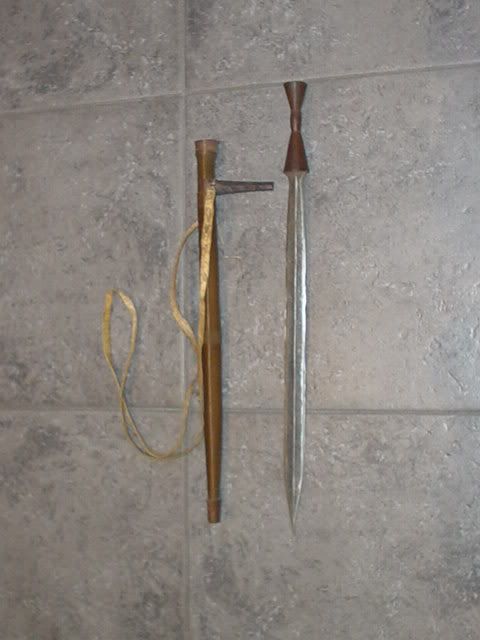 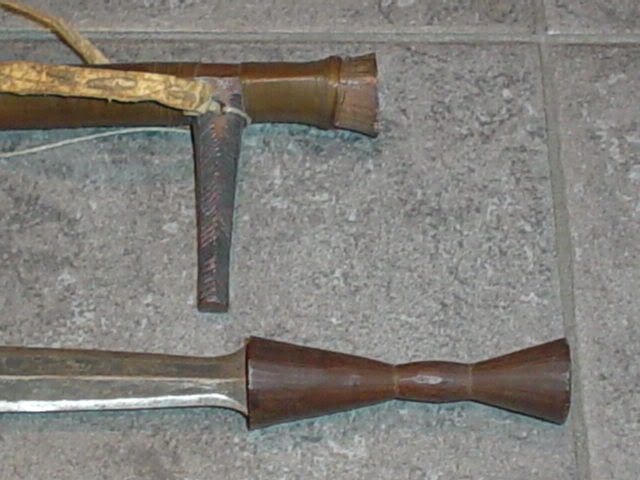  Also notice the tip of the blade. The Masai-sword is more round. The total length of this piece is 43,5 cm. The blade measures 32,5 cm. This blade has a maximum width of 1,8 cm. The wooden scabbard is completely covered with copper binding. |
|
|

|
|
|
#16 |
|
Member
Join Date: Dec 2004
Location: What is still UK
Posts: 5,925
|
I really like that
 is the scabbard wrapped with copper wire?Tim is the scabbard wrapped with copper wire?Tim
|
|
|

|
|
|
#17 |
|
Member
Join Date: Dec 2004
Location: Houston, TX, USA
Posts: 1,254
|
I don't think it's wire, but flat sheet?...hard to tell; it could be fine wire from an electric motor (a good material I see on African work; you can tell it for sure if they didn't remove the distinct half clear half red lacquery stuff electric motors coil thingies are at least often coated in; but that stuff ain't here; just brown patina, it looks like.). The long (belt?) hook on the sheath is cool.
Some might consider the sword rather similar, but I'm with you, F, and would like to elucidate. The tip is very different from the broad style of ilwoon-seme (like it?), as you say, not only in its narrow thrusting angle vs their roundish slashing (in European terms "Roman" style) tip, but also in the tip not being a widened, flattened cutting-plane; your Shi sword is basically parallell sided (except the very base), and is it sharp the whole parallel part? Just predicty-hoping  It is more a "true" cut and thrust sword, the seme more a cutting sword (a la ilwoon) with a tip that can be used for thrusting on unarmoured oponants, but ain't the greatest for it, and is more for doing a passing type cut I call tip-slashing, at which machete and seme excell, and ilwoon just makes me tear up when I see it and it's so pricey.....I could see the seme being somewhat a transitional/whatever in between sword at the edge of ilwoon(etc.) and also at the edge of true cut and thrust swords, like the Shi sword, or 'Zande broadswords, etc. Not one bit of this idea so far has really been turned toward accounting for the handles or the exact regionality/tribality/overlap of the types (broadsword and ilwoonish). This is a vague idea based on swords more than cultural geography or history, but I'm rather excited about it; please feel free to help me sew it up and fly it, or shoot holes in the wings if ye must It is more a "true" cut and thrust sword, the seme more a cutting sword (a la ilwoon) with a tip that can be used for thrusting on unarmoured oponants, but ain't the greatest for it, and is more for doing a passing type cut I call tip-slashing, at which machete and seme excell, and ilwoon just makes me tear up when I see it and it's so pricey.....I could see the seme being somewhat a transitional/whatever in between sword at the edge of ilwoon(etc.) and also at the edge of true cut and thrust swords, like the Shi sword, or 'Zande broadswords, etc. Not one bit of this idea so far has really been turned toward accounting for the handles or the exact regionality/tribality/overlap of the types (broadsword and ilwoonish). This is a vague idea based on swords more than cultural geography or history, but I'm rather excited about it; please feel free to help me sew it up and fly it, or shoot holes in the wings if ye must  I'm loving talking about African cutting swords; really excites me. I'm loving talking about African cutting swords; really excites me.
Last edited by tom hyle; 10th April 2005 at 06:06 PM. Reason: accuracy |
|
|

|
|
|
#18 |
|
Member
Join Date: Dec 2004
Location: Sint-Amandsberg (near Ghent, Belgium)
Posts: 830
|
Tom, I can assure you...it's copper wire. Very thin copper wire. I tried to take some pics, but my digital camera has its limits.
In the middle of the sheath, there's a band of about 1 cm where the copper wire has been twisted. This adds a small decorative element to this sheath. The edge of the blade is sharp on both sides, from point to handle. I could be used for slashing, but due to the thickness of the blade it's also ideal for stabbing. 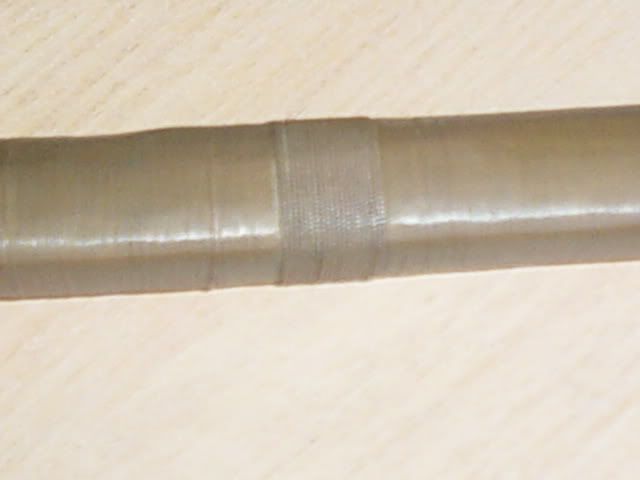 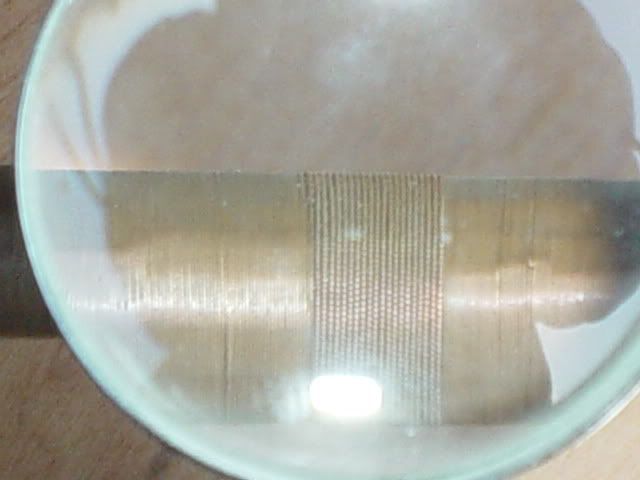
|
|
|

|
|
|
#19 |
|
Member
Join Date: Dec 2004
Location: Houston, TX, USA
Posts: 1,254
|
Thanks. Love the tonfa-like sheath. When the wood was new it might've been a real decent one-use emergency sheild?
|
|
|

|
|
|
#20 |
|
Member
Join Date: Dec 2004
Location: Italia
Posts: 1,243
|
Hello. I have a very similar short sword like the one of Freddy and i'm totally agree with him
 . there is also the band of about 1 cm where the copper wire has been twisted. . there is also the band of about 1 cm where the copper wire has been twisted.
|
|
|

|
|
|
#21 |
|
Member
Join Date: Dec 2004
Location: Houston, TX, USA
Posts: 1,254
|
rectangular raised medial? Nice.
|
|
|

|
|
|
#22 |
|
Member
Join Date: Dec 2004
Location: Sint-Amandsberg (near Ghent, Belgium)
Posts: 830
|
Flavio, what's the size of your sword ?
Here's another Tutsi dagger. Much smaller than the first one, with a total length of 26,5 cm. The blade is shaped like a spear point and measures 15,5 cm. I don't know if you can see it on the pic, but the medial has the same shape as Flavio's knife. 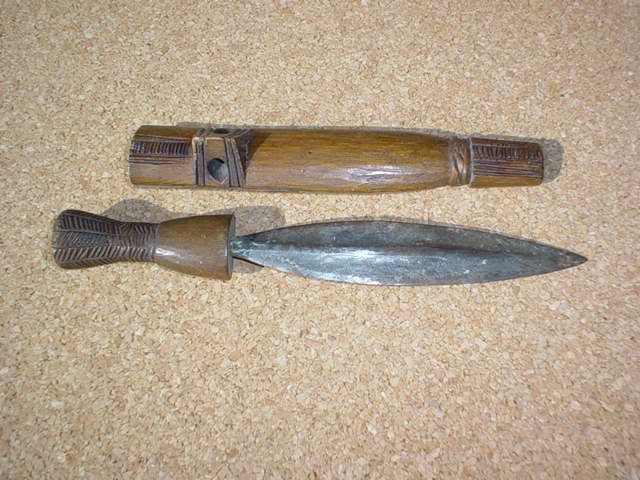
|
|
|

|
|
|
#23 |
|
Member
Join Date: Dec 2004
Location: Houston, TX, USA
Posts: 1,254
|
When you say it, I can see it; thanks. Note the talibon-like bindning block.
|
|
|

|
|
|
#24 |
|
Member
Join Date: Dec 2004
Location: Italia
Posts: 1,243
|
Hello Freddy. The measures are quite the same of your sword: the length of the blade + the handle is 42.5 cm, the maximum width of the blade 2 cm. The scabbard is in length 38 cm.
|
|
|

|
|
|
#25 |
|
Member
Join Date: Feb 2005
Location: Clearwater, Florida
Posts: 371
|
My own personal feeling is that westerners see similarities and assume, leading to all sorts of problems when you're dealing with an entirely different mind set, where religious/spiritual beliefs are often more important than form, even if it makes the weapon less effective.
The flat bladed seme knives were not originally the result of being shaved down machetes, but rather came about with the ready avilability of automobile/truck leaf springs and other weapons of war left over from the Europeans, the advent of firearms, and finally the opening of the region to tourism and the demand for souveniers. It was simply faster, less work and just as effective, thus has even spread over into the use of real user knives in many areas. The longer swords were used in inter-tribal warfare as well, which has likewise diminisheshed, making a tool shaped usage more necessary than a weapon based shape, particularly when you consider that in today's society ANY game animal has been substitued for a lion as well. As to throwing the "lion" spears or moran, there's a major flaw with that as well....the manhood initiation rites often necessitated ONE youth only on the hunt, and while throwing that spear might seem the most sensible method to us, consider the consequences when you are alone......once it's left your hand, it's gone. You're now going to kill the lion with what? An evil stare? They goaded the lion into attacking and, hopefully, impaling itself on the moran (I've seen this term used interchangably with the spear and the warrior), the seme then came into play to deliver the coup de grace' while the animal thrashed around largely incapacitated with the whole blade in its torso, much like the Roman pilums rendered enemy shields ineffective once stuck in them . The Masai also, by the way, use a second, lighter type of spear with a small, leaf shaped head and a long iron neck, suited much more to throwing even though it has the same counter-balance on the butt. In my opinion, the shape of the Ilwoon has nothing to do with the Seme other than coincedental appearance, as it is much more like other traditional swords from the Congo in flat blade and wide hilt than it is like the Seme of the Masai and plains. Some Kuba swords, for example, have the blade extending out into sharp, sideways projecting spikes at the end of the blade as well as being found in many other variations. Here are some photos of an older Shi sword, sans hilt and with an unwrapped scabbard, instead using the commonly seen fibre bindings (Artzi has a similar sword in his gallery with an Ivory hilt, a truly exceptional weapon). In my opinion, this is more of a "smash and stab" sword than a cut and thrust as the central rib is so pronounced and at such a steep angle as to be ineffective for truly deep cuts because of its extreme thickness. These swords are also unique in the manner in which they are carried, with a wide cloth strip going across the forehead and the weapon itself hanging down the middle of the back(Artzi was kind enough to forward me old photos of them being carried traditionally, which I seem to have misplaced or lost in a PC crash, sorry) This blade, by the way, is 23 1/2" to the beginning of the tang. Mike Last edited by Conogre; 11th April 2005 at 09:29 PM. |
|
|

|
|
|
#26 |
|
Member
Join Date: Dec 2004
Location: What is still UK
Posts: 5,925
|
Hello Mike.I said that spear was light enougth to throw.Well I mean only just.It would not go far.If I really had to face a lion I think it would be best to stand there, wait for the lion to leap ,shut your eyes and hope it jumped on your spear because I can not see any other options except to clean yourself up.
 Tim Tim
|
|
|

|
|
|
#27 |
|
Member
Join Date: Dec 2004
Location: Houston, TX, USA
Posts: 1,254
|
The version of the ritual Conogre describes is close to how it is usually told in N America; I do not know what the original source of this story is, or if it is/was ever done or not, or under what circumstances. I saw the one I saw; I watched it on TV. He threw the spear; it killed the lion (interestingly, I recently heard a San interviewed and asked "how do you kill a lion with only a spear?" He laughed, and said something that was translated as "you have to throw the spear just right."). He also was not alone; a semicircle of warriors, whose ends closed in together during the process until it became almost a circle, drove the lion to him.
Last edited by tom hyle; 12th April 2005 at 05:12 AM. |
|
|

|
|
|
#28 |
|
Member
Join Date: Dec 2004
Location: Houston, TX, USA
Posts: 1,254
|
I knew there was something else. Kuba ilwoon is not a flat sword. It is midribbed, with a wide flat tip, not dis-similar to the widened, flatter/thinner cutting tip on (at least my) seme.
|
|
|

|
|
|
#29 |
|
Vikingsword Staff
Join Date: Dec 2004
Location: The Aussie Bush
Posts: 4,523
|
Here is another sword similar to the seme with a spatulate blade and a diamond cross section to the "forte." The closest example I have found is in the book Afrikanische Waffen by Fisher and Zirngibl, Plate 47, p. 37. They list that sword as "Jaunde" (from Cameroon).
Ian |
|
|

|
|
|
#30 |
|
Member
Join Date: Feb 2005
Location: Clearwater, Florida
Posts: 371
|
Tom, just a point to consider....is it not possible that something "filmed" means it was organized?
All too often, particularly in older safari movie/travelogue/documentaries (Frank Buck comes immediately to mind) what is seen is distinctly different from uncoached tribal activities, such as a lion hunt vs an individual initiation rite. That one is sweet Ian, and I agree, it does look a lot liek a seme. From my experience so far, it seems likely that there are possibly hundreds or relatively unknown African weapons as so little study has been done, compared to the Philippines, or Indonesia, contributed to by both the immense size of the entire continent and the fact that so much of it was inaccessable until comparatively recent times. I apologize about the Ilwoon statement Tom, thinking about more recent specimens as opposed to your exceptionally nice one (or perhaps NOT thinking before typing is more appropriate), another case where they have changed radically in the past 50 years or so. Mike |
|
|

|
 |
| Thread Tools | Search this Thread |
| Display Modes | |
|
|